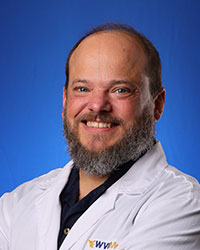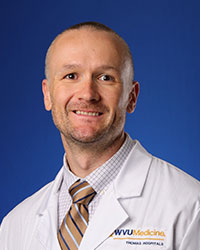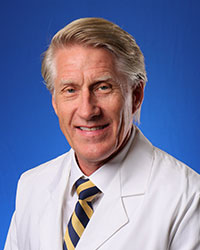When your provider needs to take a deeper look beyond what’s visible to the human eye, you may be scheduled for an imaging test. It could be a standard x-ray or a more specialized exam, like magnetic resonance imaging (MRI), computerized tomography (CT), positron emission tomography (PET), or ultrasound, used to examine the internal structure of the body.
WVU Medicine Thomas Hospitals is recognized for the highest level of imaging quality and patient safety by the American College of Radiology in computed tomography, mammography, and ultrasound. Our caring, knowledgeable, and experienced technologists are all board- and state-certified experts in their fields.
Imaging We Offer
Thomas Hospitals Imaging Services performs a variety of tests to examine internal organs, cells, and tissues where there might be a potential health concern. Our imaging capabilities include:
- Computerized tomography (CT)
- DEXA scan (bone density test)
- Diagnostic x-rays
- Lung Cancer Screenings
- Magnetic resonance imaging (MRI) including MRI Breast and MRI Prostate
- Mammography
- Nuclear Medicine
- Positron emission tomography (PET), a form of nuclear medicine
- PET-CT with prostate-specific membrane antigen (PSMA)
- Stroke perfusion (imaging of blood flow to the brain)
- Ultrasound
- Vascular Ultrasound
Appointments
Locations
Outpatient Diagnostic Center at Ashton
1095 Fledderjohn Road | Charleston, WV 25314
304-345-4674
Hours of operation: Monday – Friday, 7 am – 7 pm
Diagnostic Center on Court Street – Women’s Imaging
400 Court Street, Suite 201 | Charleston, WV 25301
304-347-6165
Hours of operation: Monday-Friday, 7:00 am – 4:30 pm
Outpatient Diagnostic Center on Court Street – MRI
400 Court Street, | Charleston, WV 25301
304-347-6674
Hours of operation: Wednesday, 8 am – 4 pm
Outpatient Diagnostic Center in Spring Hill
4800 Kanawha Avenue, SW | South Charleston, WV 25309
304-767-7730
Hours of operation: Monday – Friday, 7 am – 6 pm; Saturday, 8 am – noon
- CT and ultrasound available Monday – Friday
- Mammography/DEXA and diagnostic radiology available Monday – Friday; Saturday 8 am – noon
- PET/CT scans available Wednesday and Thursday
Medical Imaging at Thomas Orthopedic Hospital (Saint Francis Campus)
333 Laidley Street | Charleston, WV 25301
304-347-6730
Medical Imaging at Thomas Memorial Hospital
4605 MacCorkle Avenue, SW | South Charleston, WV 25309
304-766-3805
A CT scan uses computer processing and radiation to visualize nearly all parts of the body to diagnose and monitor disease, identify injury, and provide surgical guidance.
What to Expect
Before your CT scan, you may need to remove any metal objects, like jewelry, eyeglasses, or dentures, that could interfere with the clarity of the images. Ask your doctor about any preparation or other questions you might have before your imaging test.
Some CT scans require a special dye called contrast material to help highlight the blood vessels and internal structures of the body. You may receive contrast material by mouth (for esophagus or stomach imaging), by injection (for gallbladder, urinary tract, or liver imaging), or by enema (for intestinal imaging). It can take up to an hour for contrast material to distribute throughout the body before your imaging test can begin.
During the test, you lie down on a padded table that slides into a donut-shaped machine, which is open on both sides. A technologist in a separate room will be able to see and hear you at all times. You may be asked to hold your breath for a brief period at certain times to avoid any possible blurring of the images. A CT scan can take anywhere from five minutes to 30 minutes or longer depending on the part of the body that is being tested and the number of images that are needed.
Once the CT exam is completed, the images are reviewed by a board-certified radiologist, and the radiologist will send your doctor a report. Your doctor will notify you with the results. To communicate easily and securely with your WVU Medicine provider, sign up for our free patient portal, MyWVUChart.
This specific type of imaging uses a low-dose X-ray system to examine breasts and aid in the early detection and diagnosis of breast diseases. We use the most advanced mammography equipment to provide you with high-quality, 3D images using low-dose radiation during the imaging process. Our mammography technologists are certified in mammography by the ARRT. Appointments are available Monday through Friday 7 am to 5:30 pm and Saturday 8am-11:30am. Walk-ins are welcome!
What to Expect
During a mammogram, you stand in front of the mammography machine, and the technologist places one of your breasts on a platform and adjusts the platform to a comfortable height for you. The technologist helps you position your head, arms, and torso to allow a clear and unobstructed view of your breast tissue. Your breast is gradually compressed against the platform by a clear, plastic plate. Pressure is applied for a few seconds to spread the breast tissue out.
Compression of the breast minimizes the dose of radiation needed to penetrate the tissue and holds your breast still to decrease blurring from movement. During the brief x-ray exposure, you’ll be asked to remain still, and compression will automatically release once the exposure is complete.
After images are made of both your breasts, the technologist will check the quality of the images. If the views are inadequate for technical reasons, such as motion or the need to include more breast tissue than what is seen, you may have to repeat part of the test.
After the test, you are free to leave once your imaging is complete. According to federal law, you will be notified of the results of your mammogram within 30 days, but you can usually expect to receive your results sooner. Your result letter will be mailed to you the day after your exam is read by the radiologist. To communicate easily and securely with your WVU Medicine provider, sign up for our free patient portal, MyWVUChart.
Magnetic resonance imaging (MRI) is a noninvasive, high-resolution imaging technique used to look at internal organs, tissues, and the skeletal system to help diagnose a variety of medical conditions.
What to Expect
During the MRI exam, you lie on a padded table that slides into a tube-like machine, which is open on both sides. A technologist monitors you from another room, and you may speak with the technologist by squeezing a ball and talking through a microphone. You’ll also wear protective headphones or earplugs to protect your hearing from loud noises the MRI scanner produces.
You’ll need to lie as still as possible during the MRI, so that clear and accurate images can be captured. Most MRI exams take between 20 and 45 minutes, but other MRIs may take 60 to 90 minutes or longer, depending on the part of the body being scanned and how many images are needed.
Once the MRI is complete, the images are reviewed by a board-certified radiologist, and the radiologist will send your doctor a report. Your doctor will notify you with the results. To communicate easily and securely with your WVU Medicine provider, sign up for our free patient portal, MyWVUChart.
Nuclear medicine is a specialized area of radiology that can help diagnose and treat various conditions, such as tumors, infections, hematomas, organ enlargement, and cysts, by using very small amounts of radioactive materials called radiopharmaceuticals. The dose of radiation is very low and is not harmful.
Nuclear medicine may be used to treat hyperthyroidism, thyroid cancer, and lymphomas and provide treatment options for other complex cancerous conditions, including prostate cancer that has spread to the bones and stage IV colon cancer that has spread to the liver.
What to expect
Depending on the type of nuclear medicine exam you’re having, radiopharmaceuticals will be injected intravenously, swallowed, or inhaled as a gas. Except for intravenous injections, most nuclear medicine procedures are painless and are rarely associated with significant discomfort or side effects.
It can take anywhere from a few seconds to several days for the radiotracer to travel through the body and accumulate in the organ or area of the body being studied. Your imaging test may be performed immediately, a few hours later, or even several days after you’ve received the radiopharmaceuticals.
When it’s time for the imaging to begin, the radiopharmaceuticals emit a very small amount of radiation that’s detected by the camera. The scanner takes a series of images and may rotate around you while you lie in one position. You may be asked to change positions in between images. You’ll need to remain as still as possible during the exam, so that clear, accurate images may be captured. The length of time for nuclear medicine imaging varies widely, depending on the type of exam. Actual scanning can take 20 minutes to several hours or may be conducted over several days.
Once your nuclear medicine procedure is complete, the images will be reviewed by a board-certified radiologist. Your doctor will receive an electronic copy of the imaging report and notify you with the results. To communicate easily and securely with your WVU Medicine provider, sign up for our free patient portal, MyWVUChart.
WVU Medicine Imaging Services uses positron emission tomography (PET), a form of nuclear medicine, and computerized tomography (CT) in a single imaging device to provide more accurate diagnoses than two separate scans. Our PET-CT imaging can also be used to help plan more targeted radiation therapy and reduce the patient’s amount of radiation exposure.
What to Expect
Before the PET-CT exam, a blood glucose check is performed, and a radioactive tracer is injected through an IV. The amount of the radionuclide injected is very small, and there is no need for precautions against radiation exposure. Your entire body will be scanned to obtain a full evaluation of your metabolic activity.
After the scan, you can resume your normal daily activities and eating habits. You’ll need to drink plenty of fluids for the next 24-48 hours to help flush out the radioactive material from your body. Once the PET-CT exam is completed, the images are reviewed by a board-certified radiologist, and the radiologist will send your doctor a report. Your doctor will notify you with the results. To communicate easily and securely with your WVU Medicine provider, sign up for our free patient portal, MyWVUChart.
Ultrasound (sonography) is an imaging test that uses high-frequency sound waves to provide images of soft tissue and internal organs without the use of radiation.
What to Expect
An external ultrasound uses a small probe called a transducer that is placed on the skin along with a gel-like substance. The image from the probe is displayed on a monitor while the scan is performed. Some ultrasounds, like pelvic or vaginal, require a small probe to be inserted into the body. Most ultrasounds last only a few minutes, while others may take about 15 to 45 minutes, depending on the part of the body being examined.
Once your ultrasound is complete, the images will be reviewed by a board-certified radiologist. Your doctor will receive an electronic copy of the imaging report and notify you with the results. To communicate easily and securely with your WVU Medicine provider, sign up for our free patient portal, MyWVUChart.












